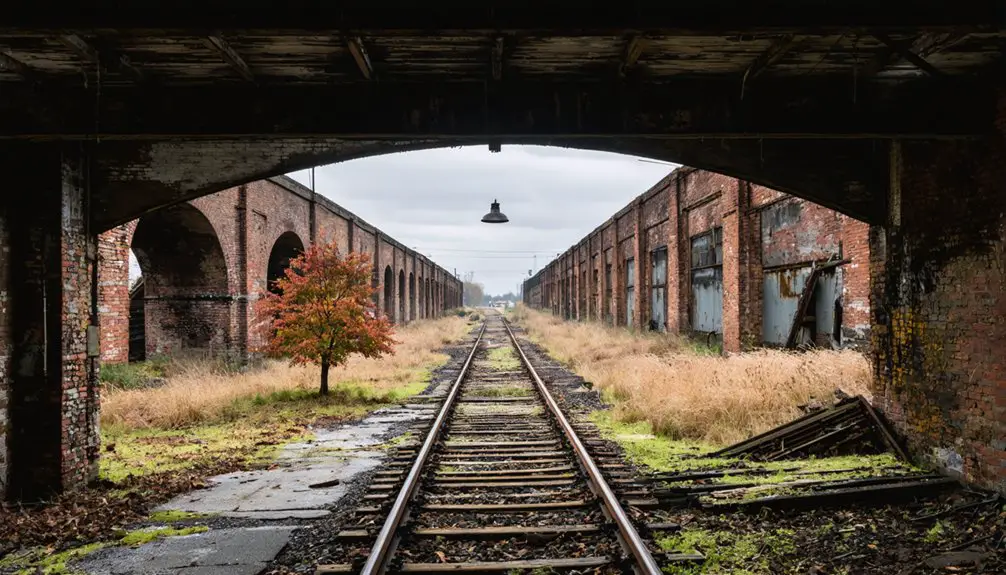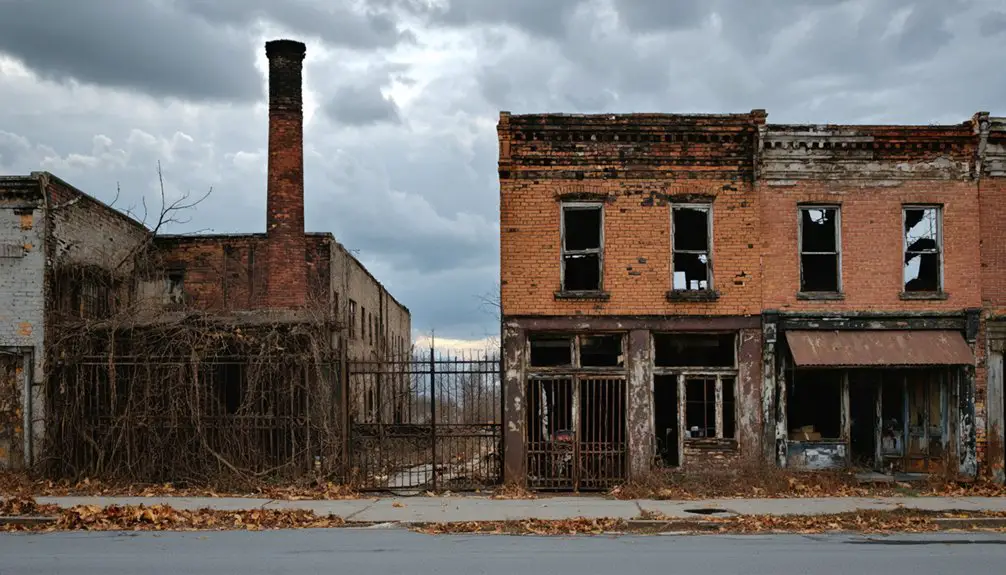You’ll find Acme, Pennsylvania nestled in a region shaped by coal and iron ore mining during the mid-1800s. The town peaked at 2,800 residents before environmental challenges, including underground fires burning at 900°F and toxic water issues from the Max Environmental landfill, led to its decline. Today, you can explore its haunting remnants – from weathered storefronts to scattered mining relics – each telling a story of America’s industrial past.
Key Takeaways
- Acme transformed from a thriving mining town of 2,800 residents to a semi-abandoned settlement due to depleted coal resources.
- Environmental hazards including underground fires, toxic waste, and contaminated water contributed to the town’s abandonment.
- The town’s decline accelerated after devastating floods in 1926-1927 and the Great Depression.
- Remnants of ore washing facilities, coal processing plants, and abandoned infrastructure mark Acme’s industrial mining heritage.
- Nature has reclaimed much of Acme, with vegetation covering former bustling streets and structures deteriorating over time.
Historical Origins and Geographic Location
While Native American tribes originally inhabited the land that would become Centralia, the area’s documented history began in 1749 when colonial agents purchased the territory for £500.
These colonial transactions set the stage for future development, with Revolutionary War hero Robert Morris acquiring the land before it ultimately passed to Stephen Girard, who recognized the value of local anthracite deposits.
You’ll find Centralia nestled in Columbia County, Northeastern Pennsylvania, where the Reading Road, built in 1770, connected Reading to Fort Augusta.
The area’s mining origins trace back to the 1842 purchase by the Locust Mountain Coal and Iron Company. The town flourished into a bustling community with nearly 2,800 residents by the late 1800s.
Situated between Mount Carmel and Ashland, the town’s valley location proved ideal for accessing rich anthracite seams that would define its future. The area’s economic prosperity continued until toxic fumes from the underground mine fire forced most residents to relocate.
Environmental Impact and Natural Disasters
Although Acme’s industrial legacy spans over a century, the town’s environmental challenges stem primarily from three devastating sources: the Max Environmental landfill’s hazardous waste, underground coal fires reminiscent of Centralia’s inferno, and extensive water contamination from mining operations. Like many towns facing similar issues, Acme required a disambiguation process to distinguish it from other locations with environmental challenges.
You’ll find stark evidence of environmental degradation throughout the region, where the Max Environmental landfill’s discharge into Sewickley Creek has turned waters yellow and foamy. Testing reveals toxic metals and cadmium consistently exceeding safety standards.
Underground fires burning at 900°F create unstable terrain and release toxic gases, while over 130 abandoned mine discharge sites poison the Indian Creek watershed.
Despite $9 million in restoration efforts, the region’s disaster preparedness remains challenged by continuous land instability, resulting in dangerous rockslides and sinkholes that threaten what remains of this once-thriving community.
Industrial Heritage and Economic Development
Before becoming a ghost town, Acme’s industrial identity was forged by the twin forces of coal and iron ore mining that dominated Pennsylvania’s economic landscape in the mid-19th century.
You’ll find evidence of its prosperous past in the skeletal remains of ore washing facilities and coal processing plants that once drove the local economy. Like Scotia’s early operations, workers initially relied on pick and shovel methods.
Like nearby Centralia and Scotia, Acme’s fortunes rose and fell with the mining industry. Railroad connections enabled the town’s growth, while the working-class culture shaped community life. Similar to Centralia’s fate, underground fires posed ongoing safety risks to the community.
Despite showing remarkable community resilience through labor struggles and dangerous working conditions, Acme couldn’t escape the inevitable industrial decline.
When resources became depleted and mining operations turned hazardous, the economic foundation crumbled. The once-bustling company town gradually emptied as workers sought opportunities elsewhere.
Transportation Networks and Infrastructure
You’ll find Acme’s transportation legacy in the convergence of its historic turnpikes and the railroad lines that shaped the town’s destiny during Pennsylvania’s industrial age.
The town’s initial road network, including local turnpikes, gradually lost importance as the railroad’s expansion made it the primary means of moving coal and passengers through the region. Stagecoaches navigating steep sections of the roads required logs dragged behind for braking. Today, the abandoned grocery store stands as a stark reminder of how transportation shifts impacted local commerce.
When the railroad operations ceased and key infrastructure crumbled, you can still trace Acme’s decline through its abandoned rail beds, deteriorating bridge foundations, and overgrown road sections that once connected this crucial hub to neighboring mining communities.
Historical Rail Line Operations
When the Pennsylvania Railroad established its main line between Harrisburg and Pittsburgh in 1846, it faced the formidable challenge of traversing the Allegheny Mountains. Under J. Edgar Thomson’s engineering expertise, the rail line followed riverbanks before tackling the steep mountain grades. The stations built during this expansion period served as vital links, evidenced by how President Lincoln’s funeral train passed through in 1865.
You’ll find the revolutionary Horseshoe Curve here, which solved major operational challenges by maintaining a grade under 2%. The line was double-tracked from inception to handle increasing traffic demands.
The 3,612-foot Gallitzin Tunnels pierced through the mountain crest, enabling a manageable descent to Johnstown. By 1854, you could travel continuously across Pennsylvania without relying on the old Allegheny Portage Railroad’s inclined planes.
The PRR’s commitment to innovation continued with steel rails replacing iron, all-steel railcars improving safety, and air brakes enhancing control – all transforming mountain railway operations into a model of engineering efficiency.
Road Access and Decline
As stagecoach lines and buggy routes initially connected Acme to neighboring settlements across Western Pennsylvania’s rugged terrain, the town’s accessibility heavily depended on a network of primitive roads and turnpikes.
The transportation evolution from these early pathways to company-built mining roads marked an essential shift in Acme’s connectivity.
You’ll find that road maintenance became increasingly challenging once mining operations ceased, as the companies that once funded infrastructure improvements were no longer present.
Without proper upkeep, the roads deteriorated, isolating Acme from critical commercial hubs and services.
The lack of maintained roadways, combined with the eventual decline of railroad service, created significant barriers to both inbound supplies and outbound labor mobility, accelerating the town’s descent into abandonment.
Infrastructure Decay Timeline
The systematic deterioration of Acme’s transportation infrastructure followed a clear pattern common to Pennsylvania mining towns in the late 19th and early 20th centuries.
You’ll find that dwindling infrastructure investments reflected the region’s economic decline, particularly after McIntyre’s coal operations ceased. The area’s transportation policies shifted from expansion to maintenance, and finally to abandonment.
- The 1870s saw the construction of McIntyre’s ambitious 2,300-foot inclined plane rail system.
- Rail lines connecting coal towns gradually fell into disuse as mines closed.
- Transportation networks became increasingly fragmented as maintenance ceased.
- By the early 20th century, only scattered rail foundations and isolated track segments remained.
Today, you can trace this decay timeline through the remnants of rail beds and abandoned rights-of-way that once served Acme’s thriving mining operations.
Population Shifts and Community Changes
During its peak in the early 20th century, Acme’s bustling coal mining operations supported a population of nearly 2,500 residents, marking the town’s most prosperous era.
As mining jobs dwindled and environmental challenges emerged, you’d have witnessed a stark urban decline that mirrors patterns seen across Pennsylvania’s coal regions.
Community resilience was tested as families faced tough decisions about staying or relocating. Unlike Centralia’s forced exodus due to underground fires, Acme’s population decrease happened more gradually through economic attrition.
Today, you’ll find only scattered residents where vibrant neighborhoods once stood. The town’s transformation from a thriving mining community to a semi-abandoned settlement reflects the broader story of Pennsylvania’s ghost towns, where industrial boom-and-bust cycles have permanently altered the landscape.
Modern-Day Remnants and Legacy

You’ll find a stark mix of decay and preservation across Acme’s remaining structures, with the namesake grocery store’s broken windows and weathered signage serving as a central landmark among the crumbling foundations.
Historic photographs reveal how time has transformed bustling streets into vegetation-covered paths, where industrial remnants like ore washer ruins now stand as silent witnesses to the town’s mining past.
While some buildings have received protective measures like brick buttresses, the gradual reclamation by nature continues, as wildflowers and deliberately planted apple trees create an evocative blend of human history and natural renewal.
Infrastructure Still Standing Today
While much of Acme’s original infrastructure has succumbed to decades of abandonment, significant remnants still dot the Pennsylvania ghost town‘s landscape today.
You’ll find residential ruins scattered throughout, with partially standing houses bearing witness to the town’s former liveliness. Along the old main street, commercial facades remind visitors of once-bustling storefronts where local business thrived.
- Route 61 cuts through the heart of town, its cracked pavement a reflection of the area’s decline.
- Mining relics, including sealed shaft entrances and rusted machinery, reveal the industrial heritage.
- Culm banks rise from the landscape, now covered in vegetation but still marking the coal processing sites.
- Original water infrastructure and electrical poles stand as silent sentinels, though long disconnected from service.
Historical Records and Photographs
Beyond the physical remnants that still stand today, Acme’s story lives on through a rich collection of historical records and photographs.
Through compelling visual storytelling, you’ll find images capturing the town’s rise and fall – from its bustling days as a cement manufacturing hub in 1911 to its decline following the devastating floods of 1926-1927.
Modern photographic archives document the ghostly transformation of this once-thriving industrial center, showing abandoned streets reclaimed by nature and the skeletal remains of the mill that once drove the local economy.
Unlike some Pennsylvania ghost towns that attract tourists, Acme’s legacy is primarily preserved through these historical photographs and documents, offering a poignant glimpse into how natural disasters and the Great Depression reshaped small industrial communities.
Frequently Asked Questions
Are There Any Paranormal Activities Reported in Abandoned Buildings of Acme?
You won’t find documented ghost sightings or haunted locations in Acme’s abandoned buildings. Unlike Pennsylvania’s famous haunted towns like Centralia, there aren’t any credible paranormal reports from this area.
What Happened to the Families Who Lived in Acme After Closure?
You won’t find clear records of family relocation from Acme, as it’s distinct from Centralia’s documented exodus. The economic impact on local families remains largely unrecorded in historical archives.
Can Visitors Legally Explore the Remaining Structures in Acme Today?
Like many ghost towns, you’ll find exploration regulations restrict access to private structures in Acme. You’re only permitted on public roads – trespassing in buildings violates local laws and visitor safety protocols.
Were There Any Schools or Churches Established During Acme’s Peak?
You’ll find Centralia’s school history included elementary schools, a high school, and two Catholic parochial schools. Church significance was marked by Ukrainian Orthodox and Catholic churches with rectories serving the peak population.
Did Any Famous Historical Figures Visit or Have Connections to Acme?
Unlike Centralia’s connection to Robert Morris, you won’t find documented famous visitors or historical connections to Acme. Research shows no evidence of notable figures visiting this small Pennsylvania mining community.
References
- https://www.islands.com/1824527/america-burning-ghost-town-once-thriving-quintessential-mining-destination-pennsylvania-centralia-fire/
- https://www.southwestledger.news/news/former-mill-town-acme-now-ghost-its-former-self
- https://www.youtube.com/watch?v=Qj5LjacccJ0
- https://en.wikipedia.org/wiki/List_of_ghost_towns_in_Pennsylvania
- https://www.youtube.com/watch?v=rgB-aMpFh7w
- https://pabucketlist.com/the-rise-and-fall-of-centralia-pas-toxic-ghost-town/
- https://en.wikipedia.org/wiki/Centralia
- https://www.youtube.com/watch?v=NcDbPf4pkCA
- https://insideclimatenews.org/news/23022025/hazardous-waste-in-small-pennsylvania-town/
- https://mtwatershed.com/rustic-ridge-coal-mine/



